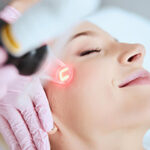The experts at Michigan Oculofacial Specialists can help relieve the discomfort experienced by patients with blepharospasm in Detroit. Have you been noticing unusual spasms and twitching along with frequent blinking on either both sides or one side of your face? This condition, known as blepharospasm, begins with minor symptoms but can become much more severe with time if it is left untreated. If you’re currently experiencing involuntary facial spasms that occur spontaneously and with repetition, then it’s important that you seek treatment before the issue intensifies.
What is Blepharospasm?
Blepharospasm is a medical condition signified by involuntary twitching of the muscles that control your facial expressions. It can affect either side of the face and in some cases, both sides become affected. Many people who suffer from blepharospasm often experience spasms in the eyes that cause them to wink and visible facial tics.
These spasms can adversely affect different aspects of your life. Social interactions, whether they are personal or professional, can become extremely problematic and anxiety inducing for those dealing with this issue. If left untreated, your quality of life may degrade over time and lead to psychological problems like depression.
What are the Symptoms of Blepharospasm?
Before treating blepharospasm, it’s important that you understand the symptoms to look out for. Most people develop the condition without any significant signs or warnings. If you are afflicted with the condition, you may begin to notice an increase in blinking or eye irritation. Some people even experience sensitivity to bright lights and facial fatigue.
In time, these symptoms will intensify,and eventually lead to forceful facial spasms in the eyelids. Advanced cases have been known to render patients unable to open their eyes. This can significantly affect a person’s ability to perform activities necessary to live their lives on a daily basis.
What Causes Blepharospasm?
The exact cause of blepharospasm is not fully understood, but several factors are believed to contribute to its development:
Neurological Factors – Blepharospasm is considered to be a neurological condition, often stemming from abnormal functioning of the basal ganglia, which is a part of the brain responsible for regulating movement. Disruptions in the communication between the basal ganglia and other brain regions can lead to involuntary muscle contractions, including those affecting the eyelids.
Genetic Predisposition – There appears to be a genetic component to blepharospasm, as it can sometimes run in families. Certain genetic variations or mutations may increase the likelihood of developing the condition.
Environmental Triggers – Various environmental factors can trigger or exacerbate blepharospasm in susceptible individuals. These triggers may include bright lights, wind, stress, fatigue, eye irritation, or specific visual stimuli. However, it’s important to note that triggers can vary from person to person, and not everyone with blepharospasm will have the same triggers.
Medications or Medical Conditions – In some cases, certain medications or underlying medical conditions may contribute to the development of blepharospasm. Medications such as dopamine-blocking drugs or antipsychotics have been associated with the onset of spasms. Medical conditions such as dry eyes, eye infections, or neurological disorders like Parkinson’s disease or multiple sclerosis may also be linked to blepharospasm.
Stress and Emotional Factors – Emotional stress and anxiety can sometimes trigger or worsen blepharospasm. Individuals with high stress or anxiety levels may be more prone to experiencing spasms.
How Is Blepharospasm Diagnosed?
Diagnosis of blepharospasm is typically based on the presence of characteristic symptoms and a thorough health assessment. At Michigan Oculofacial Specialists, our experts will conduct a physical examination, review your medical history, and possibly order additional tests to rule out other underlying conditions. They will then review treatment options with you and recommend an ideal treatment.
Treating Blepharospasm with Botox
While there is no true cure for blepharospasm, there are ways that it can be managed. One of the most effective treatment options is Botox. This popular cosmetic injectable has a wide range of uses outside of simply being used to eliminate wrinkles and fine lines.
Botox has the ability to neutralize the signals being sent to the facial muscles that causes them to spasm. It is composed of botulinum toxin, a substance that paralyzes the specifically targeted muscles in the face. It’s a safe and effective treatment option that has helped many patients find relief from the effects of blepharospasm.
Are you a Candidate for Blepharospasm Treatment?
Before undergoing treatment for Blepharospasm, you will first need to schedule a consultation with the Michigan Oculofacial Specialists. We’ll assess the current state of facial muscles and talk to you about your medical history to make sure that you’re a good fit for the procedure. If you are in good health and have no prior history of allergic reactions to substances like Botox, then you’d make a good candidate for the treatment.
The results are amazing!
Dr. Pearce was recommended by a friend who had eyelid surgery for droop, which I needed also. From the first appointment, he spent plenty of time with me explaining and answering all my questions (even by phone and email as surgery neared). The results are amazing! Scar lines are clean and fading quickly (7 weeks post-surgery now), peripheral vision better and so much more light! The bonus is a much younger look. Highly recommend Dr. Pearce and the team at his surgery center also.
How Much Does Blepharospasm Treatment Cost?
Similarly to how Botox treatments are priced, blepharospasm treatments vary in cost from person to person. After analyzing your facial muscles, we’ll develop a plan of action to address your specific needs. This includes how much Botox is necessary to reach your goal. Once the preparations are made, we’ll discuss the cost of the treatment.
Contact Our Office
At Michigan Oculofacial Specialists, our first priority is to provide you with excellent care and results that you can leave happy with. If you’re interested in learning more about blepharospasm treatment, contact our office to schedule your consultation today.



